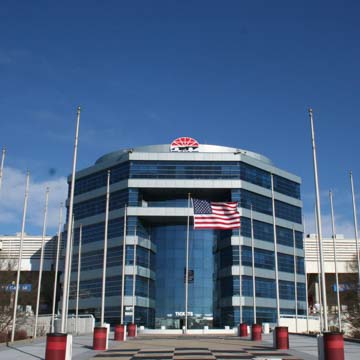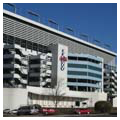You are here
Charlotte Motor Speedway
Charlotte Motor Speedway is often considered the home of NASCAR (National Association for Stock Car Auto Racing). Racing fast cars grew out of the moonshiner’s need to outrun federal agents during the Prohibition era. This intersection of “vices” helped create the heritage that is now identified with NASCAR. Formerly known as Lowe’s Motor Speedway, today Charlotte Motor Speedway is a major center of NASCAR racing. Recently, the stock car racing industry has contributed over $5 billion annually to the North Carolina economy.
The Speedway covers about 2,000 acres in Concord, about thirteen miles northeast of Charlotte on U.S. Route 29. The facility itself is not architecturally significant, but the Speedway is important to North Carolina as a social and cultural site. The first NASCAR Strictly Stock car race was hosted in 1949 at this track’s predecessor, the Charlotte Speedway, located on Little Rock Road just south of I-85; the interstate highway was built circa 1960 over the track’s parking area, which led to the facility’s closure. In the following years, NASCAR racing became a much beloved sport in the area, leading to the development and construction of the Charlotte Motor Speedway’s 1.5 mile superspeedway track in Concord by Curtis Turner and Bruton Smith. Groundbreaking for the speedway’s construction was held in 1959, and the track opened for its first race in June 19, 1960. The 1.5-mile-long oval track features 24-degree banked turns with an additional 2.25-mile road course, six-tenths-mile karting layout, and a quarter-mile oval within the outer oval.
In the early years, the Speedway experienced several difficulties, including disagreements amongst the partners, track paving failures, and low ticket sales. The partners filed for bankruptcy in 1961 and Smith left in 1962. The track continued to struggle until Smith returned to purchase majority stakeholder control in 1975. Under the guidance of Smith and his general manager, H.A. “Humpy” Wheeler, the Charlotte Motor Speedway began to improve the fan experience by constructing new grandstands regularly, adding large private suites, and corporate amenities like the Speedway Club throughout the 1970s and 1980s. In addition to these, Charlotte Motor Speedway was the first speedway to implement several innovative additions to the track. In 1984, the construction of Turn One Condominiums, comprising 40 individually owned units, made Charlotte Motor Speedway the first American sports facility to offer permanent housing accommodations for fans. In 1988, the construction of the seven-story Smith Tower increased the presence of corporate amenities and private suites at the track.
In 1992, Charlotte Motor Speedway became the first speedway to be effectively lit at night, using an innovative Musco lighting system that simulates daylight to eliminate dangerous glare and shadows; thus it was the first contemporary track to host night races. In 2011, the world’s largest HDTV—200 feet wide by 80 feet tall—was installed along the backstretch of the racetrack. With over 9 million LEDs, the large screen allows fans around the track an enhanced viewing experience. Solar panels have been installed to reduce energy costs.
The facility continues to undergo major modifications as the popularity and demographics of the sport change. Seating capacity is much reduced from the 171,000 permanent seats it had it 2001 to the 86,000 seats today. In recent years, the complex has regularly expanded, adding new features outside the oval, such as a one-fifth-mile oval, a four-tenths-mile clay oval, and a dragway.
References
Ahuja, Jay. “Lowes Motor Speedway.” In Speed Dreams: A Guide to America’s 23 NASCAR Tracks, 179-193. New York: Citadel Press, 2002.
“History.” Charlotte Motor Speedway. Accessed January 28, 2019. http://www.charlottemotorspeedway.com/.
McKim, Buz. “NASCAR’s North Carolina Roots.” NCpedia. Accessed January 28, 2019. http://ncpedia.org/.
North Carolina Office of Archives & History - Department of Cultural Resources. “Marker: L-105.” North Carolina Highway Historical Marker Program. Accessed January 28, 2019. http://www.ncmarkers.com/.
“Solar panels, cabanas part of latest changes at CLT speedway.” Charlotte Business Journal, April 4, 2017.
“Speedway Facts.” Charlotte Motor Speedway. Accessed January 28, 2019. http://www.charlottemotorspeedway.com/.
Williams, Deb . Charlotte Motor Speedway History: From Granite to Gold, Charleston, SC: History Press, 2013.
Writing Credits
If SAH Archipedia has been useful to you, please consider supporting it.
SAH Archipedia tells the story of the United States through its buildings, landscapes, and cities. This freely available resource empowers the public with authoritative knowledge that deepens their understanding and appreciation of the built environment. But the Society of Architectural Historians, which created SAH Archipedia with University of Virginia Press, needs your support to maintain the high-caliber research, writing, photography, cartography, editing, design, and programming that make SAH Archipedia a trusted online resource available to all who value the history of place, heritage tourism, and learning.



















